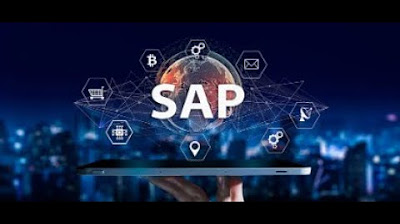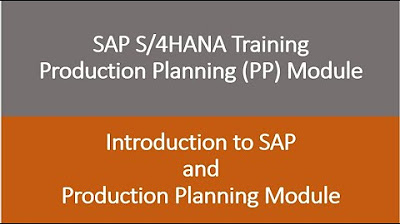SAP BASIS -- ERP VERSIONS 1
Summary
TLDRThe script provides an in-depth look at the evolution of SAP ERP systems, starting from R3 4.6 C with its application server focus, through to the integration of internet capabilities in R3 4.7 and the introduction of SAP ECC 5.0 and 6.0. It explains the significance of the application, web application servers, and the shift towards internet-based business. The script also highlights the importance of the BIW/BW component for data analysis in the digital marketplace, emphasizing the need for businesses to adapt to technological advancements.
Takeaways
- 😀 The script discusses the evolution of SAP ERP systems, starting from R/3 4.6C to the latest S/4 HANA.
- 🔍 It explains the concept of servers and their roles in a network, including the specific tasks of print servers and application servers.
- 🛠️ The script outlines the different versions of SAP software, such as R/3 4.6C, R/3 4.7x, Enterprise Edition, and ECC 6.0, highlighting their unique features and the components included with each.
- 💼 The importance of SAP Basis, which is responsible for the administration and customization of the SAP system, is emphasized.
- 🔑 The script clarifies the difference between ERP and non-ERP components, with ERP systems integrating various business modules like Logistics and HR.
- 🌐 The transition of SAP from application servers to web application servers, and the integration of internet capabilities into SAP software, is discussed.
- 📈 The introduction of SAP ECC 5.0 marks a significant shift, as it includes SAP BW (Business Warehouse) for data analysis and business intelligence, responding to the rise of e-marketing and the need for competitive business analysis.
- 🚀 The script mentions the continuous updates and improvements in SAP technology, with new versions released almost annually, to stay competitive in the market.
- 🔄 The necessity for data warehousing and business intelligence in modern business practices is highlighted, with BIW evolving into BW to support this need.
- 🔑 The script also touches on the technical aspects of SAP, such as kernel versions and the significance of these versions in the functionality of the software.
- 📚 The importance of understanding the components of SAP systems, whether they are ERP or non-ERP, is stressed for effective system administration and business operations.
Q & A
What is the prime concept discussed in the video script?
-The prime concept discussed in the video script is the evolution of SAP ERP systems, their versions, and the technical components involved in setting up and understanding SAP systems.
What does SAP stand for?
-SAP stands for Systems, Applications, and Products in Data Processing, which is an enterprise software company that provides software for managing business operations and customer relations.
What is the difference between SAP R3 4.6C and R3 4.7 Enterprise Edition?
-SAP R3 4.6C was an application server-only version, while R3 4.7 Enterprise Edition introduced the integration of the Internet Transaction Server (ITS), allowing for web-based connectivity and support for internet-related functionalities.
What is meant by the term 'application server' in the context of SAP systems?
-An application server in the context of SAP systems refers to a server dedicated to running business applications, specifically the SAP software, which handles ERP functionalities.
What is the role of an ITS (Internet Transaction Server) in SAP systems?
-The role of an ITS in SAP systems is to provide web connectivity and support for internet-based transactions, allowing users to connect to the SAP system through a web browser.
What are the default software components included when installing any SAP ERP software?
-The default software components included when installing any SAP ERP software are the SAP Basis package, SAP ABAP package, SAP BW package, and the HR and Logistics packages.
What is the significance of the term 'BW' in SAP software?
-The term 'BW' in SAP software stands for Business Warehouse, which is a data warehousing application that supports business intelligence and analysis of business data.
What is the difference between OLTP and OLAP databases in the context of SAP?
-OLTP (Online Transaction Processing) databases are used for managing real-time transactions, while OLAP (Online Analytical Processing) databases are used for analyzing and reporting on business data, often used in data warehousing systems like SAP BW.
What is the role of a BASIS administrator in SAP systems?
-A BASIS administrator in SAP systems is responsible for the maintenance and administration of the SAP system, including tasks related to system configuration, user management, and ensuring system performance and security.
What does the transition from SAP R3 to ECC signify in terms of SAP software evolution?
-The transition from SAP R3 to ECC (Enterprise Central Component) signifies a move towards a more integrated and web-enabled business suite, with ECC 5.0 being the last product under the R3 tag, and subsequent versions dropping the R3 designation.
What is the significance of the kernel version in SAP software?
-The kernel version in SAP software signifies the underlying technology platform and capabilities of the SAP system. Changes in the kernel version often indicate significant updates or enhancements in the system's architecture and functionality.
Outlines

This section is available to paid users only. Please upgrade to access this part.
Upgrade NowMindmap

This section is available to paid users only. Please upgrade to access this part.
Upgrade NowKeywords

This section is available to paid users only. Please upgrade to access this part.
Upgrade NowHighlights

This section is available to paid users only. Please upgrade to access this part.
Upgrade NowTranscripts

This section is available to paid users only. Please upgrade to access this part.
Upgrade NowBrowse More Related Video

What is SAP CPI Ariba Adapter? #ariba #sapcpi #integration

SAP S4HANA BASIS- DEMO

Video 01 - SAP S/4HANA Production Planning (PP) Module training - Introduction to SAP and PP

"SAP Cloud for Customer (SAP C4C) Q&A", 50 Most Asked Interview Q&A of "SAP C4C" for Interviews !!

APACHE- ICU scoring system( SIMPLIFIED)

Apa Itu ERP? History, Manfaat, Fitur dan Tips Memilih Vendor ERP!
5.0 / 5 (0 votes)